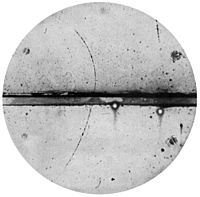Positron facts for kids

Cloud chamber photograph by C. D. Anderson of the first positron ever identified. A 6 mm lead plate separates the chamber. The deflection and direction of the particle's ion trail indicate that the particle is a positron.
|
|
| Composition | Elementary particle |
|---|---|
| Statistics | Fermionic |
| Generation | First |
| Interactions | Gravity, Electromagnetic, Weak |
| Symbol | Error no symbol defined, Error no symbol defined |
| Antiparticle | Electron |
| Theorized | Paul Dirac (1928) |
| Discovered | Carl D. Anderson (1932) |
| Mass | me
9.10938356(11)×10−31 kg |
| Electric charge | +1 e +1.602176565(35)×10−19 C |
| Spin | 12 (same as electron) |
A positron is like the opposite twin of an electron. It's a tiny particle, just like an electron. Positrons have the same mass and spin (a kind of rotation) as electrons. But here's the big difference: an electron has a negative charge, while a positron has a positive charge.
Positrons are a type of antimatter. When a positron meets an electron, they are both destroyed. This process is called annihilation. Their mass turns into pure energy. This energy then often creates light photons.
A positron can also sometimes form a special structure called positronium. Positronium is a bit like a tiny, temporary atom. It's made of an electron and a positron orbiting each other. However, it's very unstable and quickly annihilates.
Contents
What is Antimatter?
Antimatter is like a mirror image of regular matter. Every particle of matter has an antimatter partner. For example, the electron's antimatter partner is the positron. These partners have the same mass but opposite charges. When matter and antimatter meet, they destroy each other. They release a lot of energy in the process.
How Positrons Were Discovered
The idea of the positron was first suggested by a scientist named Paul Dirac in 1928. He was working on equations for electrons. His math showed that there should be another particle. This particle would have the same mass as an electron but a positive charge.
The First Sighting
Just a few years later, in 1932, another scientist named Carl D. Anderson found this particle. He was studying cosmic rays. These are high-energy particles that come from space. Anderson used a special tool called a cloud chamber. This chamber allowed him to see the paths of tiny particles.
Evidence in the Cloud Chamber
Anderson saw a particle leave a trail in his cloud chamber. This trail looked exactly like an electron's path. But it curved in the opposite direction. This meant the particle had a positive charge. It had the same mass as an electron. This was the first time a positron was ever seen. Anderson named it the "positron." His discovery proved Dirac's theory was correct.
Where Do Positrons Come From?
Positrons are not very common on Earth. They are usually created in high-energy events.
Cosmic Rays
One way positrons are made is from cosmic rays. When cosmic rays hit Earth's atmosphere, they can create many new particles. These include positrons.
Radioactive Decay
Some types of radioactive decay also produce positrons. This process is called beta-plus decay. Certain unstable atoms release a positron from their nucleus. This helps them become more stable.
Particle Accelerators
Scientists can also create positrons in laboratories. They use large machines called particle accelerators. These machines speed up particles to very high energies. Then they smash them together. This can create positrons and other exotic particles.
How Positrons Are Used
Even though positrons are rare, they have some important uses.
Medical Imaging
One of the most common uses is in medicine. Positrons are used in a medical scan called PET scans. This helps doctors see what's happening inside the human body. A patient is given a special substance that emits positrons. When these positrons meet electrons in the body, they annihilate. This creates gamma rays. Detectors around the patient pick up these gamma rays. A computer then uses this information to create detailed images. This helps doctors find diseases like cancer.
Studying Materials
Scientists also use positrons to study different materials. When positrons enter a material, they can interact with its electrons. By observing how they annihilate, scientists can learn about the material's structure. This helps them understand how materials work.
Images for kids
-
Wilson cloud chambers used to be very important particle detectors in the early days of particle physics. They were used in the discovery of the positron, muon, and kaon.
See also
 In Spanish: Positrón para niños
In Spanish: Positrón para niños


